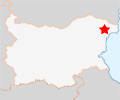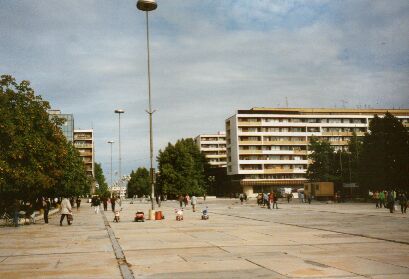Official Name
Добрич (Dobrich, also Dobritsch). The town changed its name several times - during the Ottoman and Romanian occupation, the town was known as Bazargich, during the communist reign it was called Tolbuchin. In the 1990ies, Dobrich was renamed again and so it's got its present name.
Location

| ||
| Dobrich |
Dobrich is around 40 km north of →Varna - halfway on the road to the border crossing with →Romania. Dobrich is the biggest city of a historical province called South Dobruja, a large fertile plain south of the Danube. Additionally, it's the north-easternmost town of Bulgaria. But don't expect too much.
Population
About 100,000. It's one of the bigger cities of Bulgaria and the second biggest in Dobruja - right after Constanţa in →Romania.
Orientation
There's not much left from the old city core. Dobrich has a long history, but it was flattened not just once. The centre of town (see picture below) looks like the outskirts, mainly consisting of dull concrete apartment blocks and broad concrete streets. Therefore a place most traveler avoid.
History
Dobrich marks the centre of the Southern Dobrudja (in Romanian Dobrogea), a fertile stretch of land between the Danube river and the Black Sea coast. Thanks to the fertile chernozem-like soils, the area was used as the regions granary even before it became part of the Roman empire. Needless to say that the Dobruja was popular among conquerors. After liberation from the Ottoman empire, the Dobruja was divided - the northern part became Romanian, the southern part Bulgarian territory. In 1916, Bulgaria occupied the northern part to unite the region. Only four years later, Romania conquered the entire Dobruja. The border as it is today was drawn in 1944, after liberation from Nazi Germany. The whole southern Dobruja is very rural and Bulgaria's backwater. And so Dobrich is nothing more than a provincial town - some mechanical engineering here, some food and textile production there, an open air market and so on. In and around Dobrich, there's a relatively strong Turkish minority - among them a minor Christian-orthodox Turk tribe called →Gagauz.
Getting there / transportation
Dobrich is linked to the railway network, with a few daily trains to →Varna (2 hrs), to Kardam at the border to Romania and one night train to →Sofia (9 hrs). Additionally, there are bus connections to other big cities around Bulgaria. Less than 20 km away to the north is a border crossing to →Romania near Kardam. Behind the crossing, the road leads straight to Constanţa, a big city at the Black Sea coast.
As you can easily see on the picture, Dobrich is not the most attractive place in Bulgaria. There's an Ethnographic Museum in the city centre, where you can see what Dobrich was like in better days.

| ||
| The city centre of Dobrich: Something for concrete fans |
The area around Dobrich is dominated by fields: Wheat, corn, sugar beet, sunflowers, cotton fields and here and there a vinyard. In the eastern part of Dobruja, north-east of →Varna, some popular seaside resorts line up along the Black Sea coast - a part of the coast is called Golden Sands, with tourist ghettos such as Sv. Konstantin aka Drushba and Albena. A very popular place with package tourists from Germany, England, Finland etc.
There was no reason to stay overnight, and so we went on to another place. I guess accommodation facilities are limited, because there are virtually no tourists.
- bulgaria.domino.bg/dobrich Small website about Dobrich
- www.tourism.dobrich.net Website aiming to promote the wider Dobruja area, but there's not much about the town itself.
Do you have or do you know a good website about Dobrich? Don't hesitate, let me know! After checking it, I would love to add it to the link list. You can submit a link by using the →contact form. Note that commercial websites will be treated differently.
©2024 Europe-East.com

 Albania
Albania Bulgaria
Bulgaria